 chapter 3
chapter 3
Leadership
Stop and Grow Leaders
An executive from a U.S. Department of Defense consulting company called and requested leadership training. As a good performance consultant, you immediately think “red flag.” You know from experience that a customer asking for leadership training can mean anything from a brief video to a multiyear learning experience. The first thing you have to do is find out what is the true problem that this executive needs to solve.
What They Say—The Situation
![]()
 What You Hear
What You Hear
Your conversation with the client and your research has brought you to the conclusions presented in table 3-1.
 What You Do
What You Do
Based on your conversation with the executive and your keen analytical skills, you agree to some key goals. First you identify two goals of the leadership program, the first of which is to increase sales by improving the consultants’ ability to identify new business, pursue it initially, and then bring in the salespeople when appropriate. The other goal is to reduce consultant turnover by teaching experienced managers to coach new consultants more effectively. Then, to address the communication issues, you agree that initially your program will be targeted to senior consultants who have people reporting to them with the goal of rolling out a similar program (without the coaching component) to less-senior consultants later in the year.
Table 3-1. Logical conclusions.
| What the Client Says | What You Hear |
| The client requests a specific type of training. | I think I need training to solve this business problem. Are there other things that need to be done as well? Will you help me figure out my choices? |
| Consultant retention is the problem. | Retention is the problem, but I'm not clear what is causing the problem, though we have made some assumptions from some informal feedback. |
| The consultants don't know how to communicate or lead. | I assume it's a lack of communication and people skills, but it might have other causes like incentive, workload, etc. |
Begin where all good performance solutions begin: Ask the right questions. Your training and performance instincts have already given you some good guidance, but like all successful interventions, you first have to figure out what's really behind that which is said. Here are some questions that need to be asked before the solution can be proposed:
![]() What types of behavioral changes would you like to see after the program is completed? What would make one of the senior consultants a good leader?
What types of behavioral changes would you like to see after the program is completed? What would make one of the senior consultants a good leader?
![]() How are consultants currently reimbursed for identifying sales opportunities? What is their incentive to turn new leads over to the salesforce? Are there any factors that would discourage them for turning over new leads, for example, workload, trust in the salesforce, and so forth?
How are consultants currently reimbursed for identifying sales opportunities? What is their incentive to turn new leads over to the salesforce? Are there any factors that would discourage them for turning over new leads, for example, workload, trust in the salesforce, and so forth?
![]() Whom could I talk to that is a new consultant about the challenges of staying with the company? Are there any consultants who have left whom I could talk to? Do you have any data through employee surveys that indicate that the supervisors (senior consultants) are not spending enough time with their new consultants?
Whom could I talk to that is a new consultant about the challenges of staying with the company? Are there any consultants who have left whom I could talk to? Do you have any data through employee surveys that indicate that the supervisors (senior consultants) are not spending enough time with their new consultants?
![]() How are senior consultants compensated for coaching time? What incentives are provided for them to do the coaching? Because these senior consultants are consulting at a customer's site at the same time they are supervising people at other locations, what would prevent them from spending enough time with the new people? Does their job description indicate what percentage of their time should be spent on coaching?
How are senior consultants compensated for coaching time? What incentives are provided for them to do the coaching? Because these senior consultants are consulting at a customer's site at the same time they are supervising people at other locations, what would prevent them from spending enough time with the new people? Does their job description indicate what percentage of their time should be spent on coaching?
![]() What is the industry average for retention of highly technical—and marketable—consultants? What is the goal for this company?
What is the industry average for retention of highly technical—and marketable—consultants? What is the goal for this company?
Results of Questions
When you are asking these questions, it is important to analyze the answers given to you by the employer; often, you may have to remove bias and infer the real answers to your questions. Based on the answers given to you, you have learned from asking these questions that:
![]() There is no incentive for consultants to sell through an account, and their workload prevents them from paying much attention to anything other than the work at hand. The company is currently considering a bonus for referrals and wants to emphasize this over trying to close sales themselves.
There is no incentive for consultants to sell through an account, and their workload prevents them from paying much attention to anything other than the work at hand. The company is currently considering a bonus for referrals and wants to emphasize this over trying to close sales themselves.
![]() The senior consultants rarely see their new consultants and, as one put it, “If they need something, I assume they'll email me.”
The senior consultants rarely see their new consultants and, as one put it, “If they need something, I assume they'll email me.”
![]() There is a tremendous cultural pressure for all consultants to log billable hours over everything else, including coaching.
There is a tremendous cultural pressure for all consultants to log billable hours over everything else, including coaching.
![]() Senior consultants do have clear job descriptions regarding supervision and are expected to do coaching 25 percent of their time. The company is considering a bonus for each supervisor when a new consultant hits 1 year of service with successful results.
Senior consultants do have clear job descriptions regarding supervision and are expected to do coaching 25 percent of their time. The company is considering a bonus for each supervisor when a new consultant hits 1 year of service with successful results.
What Are the Project Constraints?
The employer of the company will also provide you with constraints and parameters within which your program must come together. You have learned that for this project the constraints include:
![]() An executive overview session must be delivered in 2 months.
An executive overview session must be delivered in 2 months.
![]() The senior leadership session must be delivered in 3 months and be completed within 6 months.
The senior leadership session must be delivered in 3 months and be completed within 6 months.
![]() Training for the senior consultants will take place on weekends to avoid conflicting with billable hours.
Training for the senior consultants will take place on weekends to avoid conflicting with billable hours.
 Your Triage Intervention
Your Triage Intervention
Now you are ready to propose your solution. The plan includes the following (figure 3-1):
![]() Prerequisite 360-degree leadership competency assessments and behavioral assessments for each participant. Purpose: Establish individual competency gaps and team behavioral gaps.
Prerequisite 360-degree leadership competency assessments and behavioral assessments for each participant. Purpose: Establish individual competency gaps and team behavioral gaps.
![]() An executive 1-day demo (review) of the initial 2-day leadership class including assessments. Purpose: Establish buy-in, set roles and process for ongoing reinforcement.
An executive 1-day demo (review) of the initial 2-day leadership class including assessments. Purpose: Establish buy-in, set roles and process for ongoing reinforcement.
![]() Two 2-day sessions with homework (coaching, reading, performance review). Purpose: Allow tools and techniques practice and application and create a learning support group (other attendees).
Two 2-day sessions with homework (coaching, reading, performance review). Purpose: Allow tools and techniques practice and application and create a learning support group (other attendees).
![]() Ongoing review and fine-tuning for rollout to all other consultants.
Ongoing review and fine-tuning for rollout to all other consultants.
You only have 4 weeks to build the initial executive session, then 4 weeks after that to roll out the initial class for the first participants. Here are more details about the four elements of your solution.
1. 360-Degree Leadership Assessments
Prerequisite 360-degree leadership competency assessments and behavioral assessments are used for each participant so that the senior consultants will have an accurate perspective of their own strengths and weaknesses. The 360-degree leadership competency assessment will tell each senior consultant how they are perceived by the people who work for them, their peers, and their boss. It will also provide you as course developer with overall learning gaps for the group that you can use to prioritize classroom time. A Web assessment would be preferable to make it easier to do and summarize.
Figure 3-1. Your leadership intervention.
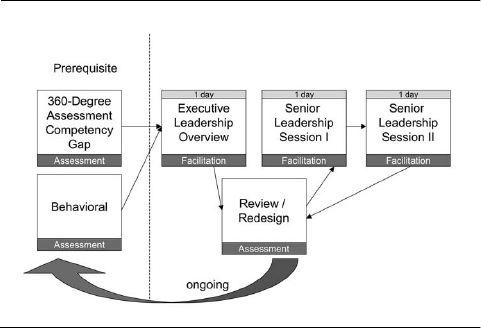
The executive will prioritize what competencies are most important to assess. You provide a standard list (Russell, 2002) of competencies from which he may select. Executives often avoid 360-degree assessments simply because they dread spending months arguing about which competencies to include. It's much more practical to pick from an existing list, and, of course, such a list can save thousands of hours and dollars for the company.
You decide to use a DISC and values assessment to help each senior consultant understand their behavioral strengths as well as what motivates them. This will help them figure out ways to get help for work that presents challenges or causes them stress because of the level of effort required. You decide to use your own Quick ‘n’ Dirty versions in the classroom, rather than as a prerequisite. You hope to get the funding to do complete commercial versions by the second classroom session after proving the worth.
2. Executive 1- and 2-Day Leadership Classes
All of the senior managers and other managers who supervise senior consultants will attend a 1-day version of the initial 2-day leadership class. The purpose will be to familiarize them with what their staff will hear and be expected to do, as well as get their buy-in to the rollout. They will do the behavioral and values assessments but not the 360-degree assessments. The 1-day session will be highlights of topics, and many of the exercises of the senior consultants’ 2-day sessions will be eliminated because of time constraints.
3. Two 2-Day Sessions With Homework
The senior consultants, handpicked by the executives, will attend a 2-day session. The content will be dictated by the results of the 360-degree leadership competency assessment, but will have a heavy emphasis on understanding and leveraging personal strengths in customer relationships, coaching, and supervising. The 360-degree leadership competency assessment will be a prerequisite to this workshop. After the workshop, the senior consultants will be asked to implement a coaching plan for their staff.
The second 2-day session will review the results of the coaching plan and drill down into more advanced coaching techniques. Again, this session will be driven by the priorities of the initial 360-degree leadership competency results. You believe this will involve more work on dealing with conflict, negotiating, and difficult coaching situations based on your discussions so far, but you won't know for sure until the results are in.
4. Review and Fine-Tune for Next Group
After the second 2-day session, you will review the behavioral results with the senior consultants and supervisors. A new plan will be built to determine what the next steps will be for the other consultants if necessary.
 What You Build
What You Build
The plan is approved, and now it is time for you to design the measurable learning objectives for each part of the proposed solution, determine facilitation requirements, and create course materials. Here are the details:
Prework:
![]() A Quick ‘n’ Dirty 360-Degree Assessment
A Quick ‘n’ Dirty 360-Degree Assessment
![]() A Quick ‘n’ Dirty Behavioral Assessment
A Quick ‘n’ Dirty Behavioral Assessment
Classwork:
![]() Personal Vision: Who am I? Why am I here?
Personal Vision: Who am I? Why am I here?
![]() Chunking: A Coaching Experience
Chunking: A Coaching Experience
![]() Coaching Role Play: Guardian Angels
Coaching Role Play: Guardian Angels
Prework
Quick ‘n’ Dirty 360-Degree Assessment
Learning Objectives. After completing this assessment, each participant will be able to identify his or her own strengths and weaknesses as seen through the eyes of his or her staff, peers, and boss.
Required Equipment and Supplies. Paper forms or a Web-based assessment are required for the assessment in addition to an email notification. Finally, you must be able to track email reports to make sure assessments are done on time and print out result reports.
You can plug these competencies into a purchased 360-degree application, use one available in a Web application such as www.surveymonkey.com, or even do the surveys using email or paper. The choice depends on your budget and the number of survey participants. A 360-degree assessment on paper is best limited to 20 participants, with five or fewer people assessing the participants. It will take between 3 and 5 hours to summarize the data given this number of assessments. A Web-based 360-degree assessment with reporting offers unlimited scalability for an estimated cost of $150 USD per person. The choice is yours.
A 360-degree assessment is most effective when the supervisor, peers, staff, and self-assessments are summarized both separately and as a whole for comparison. Obviously, the more responses, the better the results will be. It is critical to ensure two things. First, the results must remain completely anonymous, with the exception of the boss, because in general there is only one boss entry. The person getting the results will not know which people entered which ratings. The second important factor is that the language asking them for their role (supervisor, peer, staff, self) is very clear. If participants choose the wrong role, it makes the results difficult to draw conclusions from.
Step-By-Step Design. The first thing you must do is determine the appropriate people to select the competencies (as can be done with activity 3-1). Once the competencies are selected, design the 360-degree questions. In this case, the executive requesting this program will make these choices.
![]()
Send the 360-degree instrument to each participant along with a letter or email for them to use to invite others to participate. (Activity 3-2 is a sample letter.) It is important that the participant request participation, not the course developer or facilitator.
![]()
It is necessary to be specific about the date the assessment will close. Track the number of assessments done a week before the assessment is closed and ask the leadership participant to email reminders to the people who have not yet completed their assessment. This way you are sure to get a sufficient number of assessments completed before the classes.
Once you have all the data, distribute the reports and report instructions. Then, use the cumulative results to prioritize the learning objectives for the instructorled aspects of the leadership program.
Tips. Include a question for each competency asking the importance of that competency to the leadership participant's job. This way, if someone gives the leadership participant a lower ranking on a competency but also indicates that this is not a useful competency, there is not as a great a need to focus on closing the gap.
Roll assessments up from each sub-competency to major competency to show more actionable gaps. Be sure always to include instructions on how to read the reports when 360-degree reports are sent to participants, especially if you will not be able to explain them in person, to avoid misinterpretation.
 Top Priority
Top Priority
In this case, you are going to distribute the 360-degree results in the first 2-day session via these steps:
1. Ask each person to read through his or her reports silently.
2. Ask each participant to pick one strength and one weakness.
3. Break into small groups (between three and five participants in each) to share thoughts.
4. Ask each person to share an example or story of a specific time when he or she succeeded because of a strength. Ask the team to help brainstorm why the situation went well.
5. Similarly, have them share an experience when they struggled because of their selected weakness. Ask the team to help brainstorm other ways the situation could have been handled.
![]()
6. Ask each leadership participant to create an individual development plan (activity 3-3), further clarifying their strengths, weaknesses, and actions to close the gaps between the two over time.
Results. The executive chooses eight leadership competencies from the list you gave him, and you implement a Web-based 360-degree leadership competency assessment based on this. You ask the executive to send out an email that you have helped write inviting the senior consultants to participate in this leadership program, which will begin with this 360-degree assessment. The email also contains dates that assessments are due, how to pick whom to ask to do the assessment, and a high level overview of the entire program. It also shares the dates for the two 2-day sessions, so they will know in advance not to make other plans.
At first, people do not get many assessments in, but you persist with email reminders. Eventually the data is complete, well within the timeframe. The results show three overwhelmingly common gaps:
![]() The senior consultants do not feel competent in their role as coaches, and their staff does not feel as if they are coached well.
The senior consultants do not feel competent in their role as coaches, and their staff does not feel as if they are coached well.
![]() All staff felt that people above them did not listen to them.
All staff felt that people above them did not listen to them.
![]() All staff felt that it was the supervisors’ job to translate the company vision into action but this was not being done. Most consultants felt unsure how what they did aligned with the company vision and strategy.
All staff felt that it was the supervisors’ job to translate the company vision into action but this was not being done. Most consultants felt unsure how what they did aligned with the company vision and strategy.
Quick ‘n’ Dirty Behavioral Assessment
In this example, a behavioral and motivation assessment (DISC and PIAV) was done for each of the participants. Using these full profiles provides each leadership participant with the following:
![]() clarity about his or her preferred behaviors including his or her concern for tasks, people, urgency, and diligence
clarity about his or her preferred behaviors including his or her concern for tasks, people, urgency, and diligence
![]() clarity about his or her adapted behaviors—how differently the participant is behaving from his or her preferred behaviors
clarity about his or her adapted behaviors—how differently the participant is behaving from his or her preferred behaviors
![]() clarity about his or her motivators—what kinds of things are engaging and what things are distasteful.
clarity about his or her motivators—what kinds of things are engaging and what things are distasteful.
Figure 3-2 provides Quick ‘n’ Dirty versions of DISC and PIAV to use as a rapid, inexpensive option. Only use these versions as a last resort; the full versions provide much stronger learning and business returns.
In our story we found that many of the senior consultants preferred completing tasks carefully—even perfectly. They were drawn to situations where they could learn new things and had a tendency to measure success through income. The assessments also revealed that a majority of the senior consultants were not “people” people; they just did not feel comfortable one-on-one. Last, some of these senior consultants were not comfortable in their roles as coach, causing great stress to all concerned.
Learning Objectives. Each participant will learn about his or her own strengths and weaknesses as seen through behavior and motivation personal assessments.
Required Equipment and Supplies. You need to provide paper forms or Web-based assessments and instructions for interpreting the assessment results. A prerequisite assessment is used so that the upcoming leaders in your session will have a personal perspective about their own strengths and weaknesses. It also provides the facilitator with an understanding of the underlying factors creating some of the problems identified by the training sponsors.
Figure 3-2. Quick ‘n’ Dirty versions of DISC and PIAV.

Audience. Each leadership participant will do these two assessments. We have found that it is critical to ensure people that the results will remain completely anonymous. Assessment results should never be shared with anyone other than the person they concern, unless permission is given in advance. In addition, let your participants know that good assessments are very difficult to “mess around with.” The results are generally accurate, but never exact.
Step-by-Step. Distribute the assessments to participants. If possible, you should do this before you spend time together. You need to be specific about the date the assessment will close. Track the number of assessments done a week before the assessment is closed and remind the people who have not yet completed their assessment. The next phase is to distribute reports and report instructions. Finally, use the cumulative results to prioritize the learning objectives for the instructorled aspects of the leadership program.
Tips. Encourage each participant to be open to the results, even if they do not seem exactly right. I have found that the people who are most bothered by the results have the most to discover, but require you to have great patience and gentleness.
 Top Priority
Top Priority
Whether debriefing as a group or one-on-one, follow these steps:
![]() Ask each person to read through his or her reports silently, preferably before the face-to-face time.
Ask each person to read through his or her reports silently, preferably before the face-to-face time.
![]() Ask each participant to pick one strength and one weakness.
Ask each participant to pick one strength and one weakness.
![]() If working as a team, break into small groups of three to five participants to share thoughts.
If working as a team, break into small groups of three to five participants to share thoughts.
![]() In either a team or one-on-one setting, ask each person to share an example of a specific time when he or she succeeded because of a strength. Ask the team to help brainstorm why the situation went well.
In either a team or one-on-one setting, ask each person to share an example of a specific time when he or she succeeded because of a strength. Ask the team to help brainstorm why the situation went well.
![]() In either a team, or one-on-one, ask each person to share an instance when he or she struggled because of the weakness chosen. Ask the team to help brainstorm other ways the situation could have been handled.
In either a team, or one-on-one, ask each person to share an instance when he or she struggled because of the weakness chosen. Ask the team to help brainstorm other ways the situation could have been handled.
![]() Now ask each leader to think of people they have difficulty communicating with. Could it be a behavioral or motivation difference? How can that be addressed?
Now ask each leader to think of people they have difficulty communicating with. Could it be a behavioral or motivation difference? How can that be addressed?
![]() Ask each leadership participant to create an individual development plan (see activity 3-3) clarifying further their strengths, weaknesses, and actions to close the gaps in the future.
Ask each leadership participant to create an individual development plan (see activity 3-3) clarifying further their strengths, weaknesses, and actions to close the gaps in the future.
Classwork
Personal Vision: Who Am I? Why Am I Here?
In this example, each participant created a vision for his or her role at the company. The results showed that some consultants did not see themselves as part of the sales process, and often consultants restricted their role to the implementation of a technology, rather than the solving of a customer need.
Learning Objectives. Each participant will come up with his or her own description of the role he or she plays at the company, and then the group will come to a consensus.
Required Equipment and Supplies. You will need flipcharts, markers, and stickers for voting if you choose to use them.
This facilitation technique is used to create a discussion around why consultants are important to the company. It is always interesting how different people see their roles. The wide variance in responses may really surprise the participants. This is especially useful when you are hoping to help people see the role they play in serving the needs of the company's customers. In our case, we were also concerned about the role played in serving the needs of newer consultants.
Step-by-Step. Make sure each participant has blank paper and something to write with, and then proceed to tell them the following story:
Imagine that you are at a party with some people who you do not know very well. One of these people asks you where you work and what you do. You explain it to the best of your ability. Suddenly, they ask you, “Why do you work there? What is it about your job that you like so much that you get up every day and do it?”
Instruct the participants to begin to answer the question using three verbs and one noun. For example, “I promote, market, and sell products,” would be a sufficient yet succinct answer to the question with which they were presented. It is also fine to add descriptive words if necessary. The sentence, “I promote, market, and sell technology products to grocery stores,” would be a suitable, slightly more descriptive answer to the question.
Give participants 10 minutes to think about their own answers. Then, you should encourage them to get into groups of three to five people and share their answers. Give them another 10 minutes to come up with a statement consisting of three verbs and one noun that they all agree with. Ask them to write it on a flipchart page when they are in agreement.
As a large group, discuss the different meanings of each of the statements. Give everyone 10 stickers (or use colored markers). Explain to them that they each have 10 votes to cast on the words they like the best out of all the flipchart entries. Using the stickers (or checkmarks using the markers), they will individually choose their favorite verbs and nouns from the entries. They can spread the votes any way they want—they can put all 10 votes on one verb they feel strongly about, or put one vote on six verbs and four nouns. Give people 5 minutes to vote.
Identify the statement that received the most votes overall. Post it on the wall and refer back to it throughout the ongoing leadership discussions to reinforce learning.
Tips. Consider some of these ideas to get the ball rolling:
![]() Use purchased stickers that look like dollar bills, so voting really seems like spending money. Check out www.photostamps.com to create stickers of just about anything you want.
Use purchased stickers that look like dollar bills, so voting really seems like spending money. Check out www.photostamps.com to create stickers of just about anything you want.
![]() Keep the focus on the message that the people want to communicate and away from a particular word or logistics debate. What's important is that the words you use to describe yourself dictate your behavioral choices.
Keep the focus on the message that the people want to communicate and away from a particular word or logistics debate. What's important is that the words you use to describe yourself dictate your behavioral choices.
![]() You will probably have to explain the voting technique multiple times using examples. This is a tough, nonlinear concept for some people at first.
You will probably have to explain the voting technique multiple times using examples. This is a tough, nonlinear concept for some people at first.
 Top Priority
Top Priority
When debriefing the group, follow these steps:
![]() Compare verbs and/or nouns two at a time, for example, how is customer different as a noun than product? How would your job look differently?
Compare verbs and/or nouns two at a time, for example, how is customer different as a noun than product? How would your job look differently?
![]() If you have already discussed the behavioral and 360-degree assessments, integrate these into the debriefing. Which words show more sense of urgency? Which words indicate a focus on making money? Which statements seem to include coaching (or a competency that was overall weak in the group's 360-degree assessment)
If you have already discussed the behavioral and 360-degree assessments, integrate these into the debriefing. Which words show more sense of urgency? Which words indicate a focus on making money? Which statements seem to include coaching (or a competency that was overall weak in the group's 360-degree assessment)
![]() It is important to follow the steps so that each individual gets the opportunity to think first by him- or herself, then with a small group, and then as a collective. This gives them the safety and trust to investigate and try out new thoughts.
It is important to follow the steps so that each individual gets the opportunity to think first by him- or herself, then with a small group, and then as a collective. This gives them the safety and trust to investigate and try out new thoughts.
Chunking: A Coaching Experience
In this example, we use a game developed by the famed game master Thiagi (www.thiagi.com). It's an exercise called Chunking to catch people in their default coaching behaviors. Coaching was emphasized because of the results of the 360-degree assessment, however, I have not done a leadership session yet where coaching was not a developmental goal. The results of this game and discussion showed the emerging leaders that they:
![]() Tend to tell instead of ask when in a coaching situation.
Tend to tell instead of ask when in a coaching situation.
![]() Feel obligated to help a bit too much, rather than grow the person they are helping.
Feel obligated to help a bit too much, rather than grow the person they are helping.
![]() Very few think to ask the person being coached how much help he or she wants! The coach almost always decides for the person.
Very few think to ask the person being coached how much help he or she wants! The coach almost always decides for the person.
Learning Objectives. Each participant will learn about his or her own coaching strengths and weaknesses by either participating as an observer, a person being coached, or a coach.
Required Equipment and Supplies. You should provide a sufficient number of flipcharts and markers depending on the group size you will be working with. In addition, you need to provide a set of Chunking worksheets that include the Chunking game handout (activity 3-4), the hint worksheet (activity 3-5), the answer handout (activity 3-6), and an observation sheet (activity 3-7) that will help organize participants’ thoughts at the conclusion of the game.
![]()
Audience. All participants will be involved in this exercise and will play either the role of coach, person being coached, or observers.
Step-by-Step. Break the room into teams of four to five people. Determine the roles each person will play by the following rules:
1. The person with the most children will play the role of the coach (pets can be the tie breaker).
2. The person with the least years of service with the company will play the role of the person being coached.
3. All remaining people will be observers. Explain that observers will take out paper and writing utensils, and observe the coach and person being coaching, noting behaviors, phrases/language, emotions, success/failures used throughout the roleplay. They should also note what goes well and what could be improved. However, observers cannot help or speak during the activity.
4. Finally, ask each of the coaches to come up to the front for some private instructions from you. At this time, you will pass out the hint and answer handouts quickly with very little discussion. If they ask you if they can tell the person the answer, tell them they can do whatever they want.
5. Pass out the Chunking worksheet and explain how to solve the puzzle. Give each team 10 minutes to solve the puzzle.
Tips. There are a few things you can do during the activity to maximize the learning experience. First, resist the temptation to say more than you need to: the fewer instructions the better. You are trying to catch people in suboptimal coaching behaviors. You should also monitor the room to ensure that observers are observing rather than helping. (It is really hard to stay out of it.) Last, try to capture some language to share during debrief as you wander around. Observe emotions and look for language that expresses that emotion.

Top Priority
Debrief using the following process:
![]() Ask each person to write down at least one thing that went well, and one thing that could be improved in the coaching exercise.
Ask each person to write down at least one thing that went well, and one thing that could be improved in the coaching exercise.
![]() Ask the observers to share their answers first and place them on the flipchart pages with which you've provided each group.
Ask the observers to share their answers first and place them on the flipchart pages with which you've provided each group.
![]() Ask the person being coached to share his or her answers, and add them to the list.
Ask the person being coached to share his or her answers, and add them to the list.
![]() Finally, ask the coaches to share their answers.
Finally, ask the coaches to share their answers.
![]() Announce to the group that the coaches had the answers all along. Ask the coaches why they did or didn't give the answers to the person being coached. Ask the people coached how they feel about the fact that the coach did or did not give them the answer. Why did this happen? Stress the importance of a coaching session being driven by the unique needs of the person being coached.
Announce to the group that the coaches had the answers all along. Ask the coaches why they did or didn't give the answers to the person being coached. Ask the people coached how they feel about the fact that the coach did or did not give them the answer. Why did this happen? Stress the importance of a coaching session being driven by the unique needs of the person being coached.
![]() Ask each leadership participant to create an individual development plan (look back to activity 3-3), clarifying further his or her strengths, weaknesses, and actions to close the gaps in the future around coaching.
Ask each leadership participant to create an individual development plan (look back to activity 3-3), clarifying further his or her strengths, weaknesses, and actions to close the gaps in the future around coaching.
Coaching Role Play: Guardian Angels
Use this coaching role play after the Chunking exercise. This way, participants have an opportunity to practice the behaviors they have just learned and have some success.
Learning Objectives. Each participant will learn about his or her own strengths and weaknesses as a coach and will have an opportunity to try on new behaviors in a safe practice setting.
![]()
Required Equipment and Supplies. You need to provide role-play scenario worksheets (activities 3-8 and 3-9) in addition to the standard flipcharts and markers to aid the visual learners.
Audience. All participants will take a turn acting as a coach, the person being coached, and a guardian angel to one of the two.
Step-by-Step. This role play is designed to encourage misconceptions and poor judgments from both the coach and the coached, so be sure to keep an eye out for these behaviors.
1. Pass out the instructions for the role play. Give everyone a few minutes to read through the scenario.
2. Break into teams of four to five participants each. Ask for one volunteer from each team to be the coach first. Ask for one other volunteer from each group to be the coach's guardian angel. Their job will be to help the coach prepare for the coaching session, and, at any time during the role play, the coach can freeze the action to get help from the guardian angel.
3. Ask for one of the remaining team members to volunteer to be the person being coached. The others will be his or her guardian angels. Distribute a role-play scenario to them (either activity 3-8 or 3-9). Give everyone 5 minutes to prepare.
4. Begin the role play in each team and let it go on for approximately 10 minutes.
5. Debrief using the instructions in the next “Top Priority” section.
6. Ask each team to make a list of what went well and what could be improved.
7. Debrief as an entire class, and ask each group to share one lesson they learned during the role play. Capture these on a flipchart.
8. Rotate the couple who played the coach person and the coach's guardian angel to a new group where they will be the coached person and his or her guardian angel. The others in the new group will now play the role of the coach with the second role-play roles (either activity 3-8 or 3-9, whichever you did not use in the last scenario).
9. Debrief in the same way.
Tips. Be very careful to keep this a positive experience. It will be hard for some people and stressful, but the guardian angels should be a big help. Keep emphasizing the importance of learning from the experience.
Changing behavior is very hard because people don't always see their own behavior clearly. Continue to talk about how the participants will notice ways to adapt their own behaviors to the needs of someone else and that each coaching situation is unique.

Top Priority
Whether debriefing as a group or in a one-on-one situation, follow these steps:
![]() Ask each person to think about what went well and what could have been improved in the coaching role play. Individually, have each person write down three ideas for each category if he or she can.
Ask each person to think about what went well and what could have been improved in the coaching role play. Individually, have each person write down three ideas for each category if he or she can.
![]() Have each person at each table share his or her three “what went well” and “improvements,” one person at a time. Ask someone at the table to accumulate a list. Start with the observers and finish with the coach and his or her guardian angel.
Have each person at each table share his or her three “what went well” and “improvements,” one person at a time. Ask someone at the table to accumulate a list. Start with the observers and finish with the coach and his or her guardian angel.
![]() Bring everyone back together, and ask each team, in turn, to share one thing that went well and one area of improvement that no one else has said yet. Accumulate these on a flipchart at the front of the room.
Bring everyone back together, and ask each team, in turn, to share one thing that went well and one area of improvement that no one else has said yet. Accumulate these on a flipchart at the front of the room.
![]() Repeat for additional role plays.
Repeat for additional role plays.
![]() Ask each leadership participant to create an individual development plan (activity 3-3), further clarifying his or her strengths, weaknesses, and actions to close the gaps in the future.
Ask each leadership participant to create an individual development plan (activity 3-3), further clarifying his or her strengths, weaknesses, and actions to close the gaps in the future.
Customizing Tips. First, ask the participants instead of the executives, or both, to choose the competencies ahead of time. If there is no time or buy-in to do the assessment as prework, use the 360-degree assessment with only the people in the room at the start of the session. Note, however, that this will only work if people know each other fairly well. The other caveat is that the prework is difficult to distribute, and people may be too busy or lack the trust to participate. Be clear with all the executives how essential this data is and use their clout to get the assessments done.
It is critical that the CEO (or someone else with great power and respect) kicks off the classes or at least is responsible for inviting the emerging leaders through an email or letter before the session.
The executives must not only review the classes but also take them. Taking a class means they do all the exercises and live the experience so that they can support their learners more fully. It is critical that at least one of the executives attends as a student in each instructor-led class. At a minimum, an executive can attend as a guest speaker and share his or her own leadership challenges to model high-level buy-in and support.
Carry the vision exercise results from the executives’ overview into the class with the participants. Comparing these two “answers” can create powerful discussion and learning opportunities.
Measuring Your Success
There are multiple difficulties measuring the return-on-investment (ROI) of leadership initiatives. First of all, measuring the growth in competencies (which can be done with another 360-degree assessment after a period of time) does not necessarily indicate that business value has occurred. In addition, it can be misleading to measure a business indicator, in our case a growth in sales and a growth in retention, because there are many other external factors (such as the economy) that can affect the numbers. Also, measuring competencies or business indicators can only be done after enough time has passed to see results. Measuring competency improvement makes no sense unless at least six months have passed. Measuring business results usually takes between 12 and 18 months.
As dismal as this may look, there are some ways that measurements can be made. Using the email surveys (activity 3-2), ask stakeholders (executive sponsors, 360-degree assessment participants, and so forth) to subjectively evaluate the improvement for the business. You can also track the financial numbers from sales, retention, and similar measures that you established in the beginning as the goal. Detail the other factors that may have affected these numbers, both in the positive and negative.
In our story, building accountability and partnership had an expected and unexpected result. The consultants felt more a part of the company and, therefore, expressed ideas and complaints that they were hesitant to express prior to the program. The executives initially responded openly to these concerns, but were not able to finish the job. A key barrier was that consultants’ pay and bonuses were tied to on-the-job hourly work, and when senior consultants spent time coaching new consultants, it cost them both money. The executives were not willing to change the incentives and job descriptions, so the change they desired did not occur.
Debrief
When you have an executive sponsor asking for training for people who think they don't have a problem, you have a special challenge. In this case, these were highly talented people and the business had not asked them to be great at consulting until this point. The use of 360-degree and behavioral assessments was the critical data needed to get buy-in from the learners. This way, the perception of the executive sponsor was not the only voice that the learners heard.
These types of problems, however, cannot be solved with just a training intervention. Without reworking the job roles, the compensation, and the processes as well as educating the upper management, the change of long-term improvement is very low.
In the next chapter, you will read about a situation that is much more time critical. What do you do when a project team just can't seem to work together and a new product rollout is failing because of the dynamics of the team?
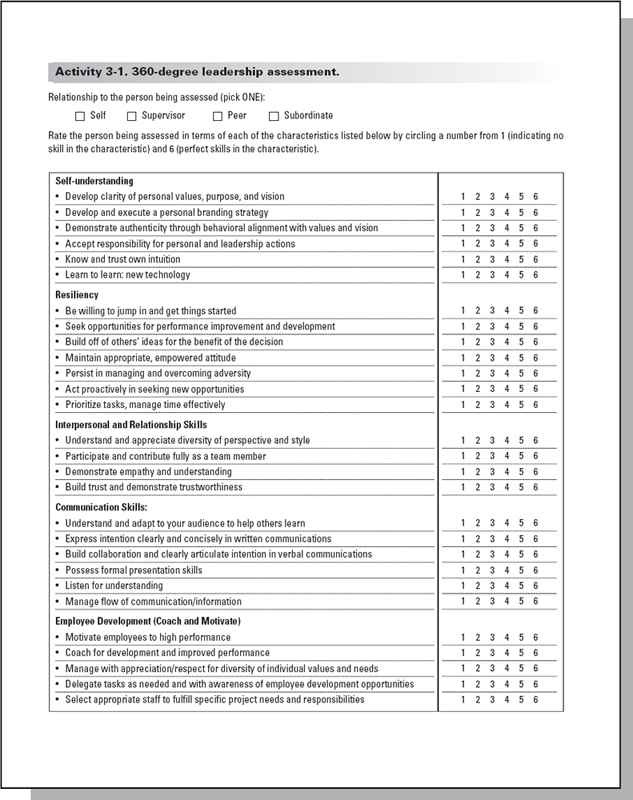
Activity 3-1, page 1
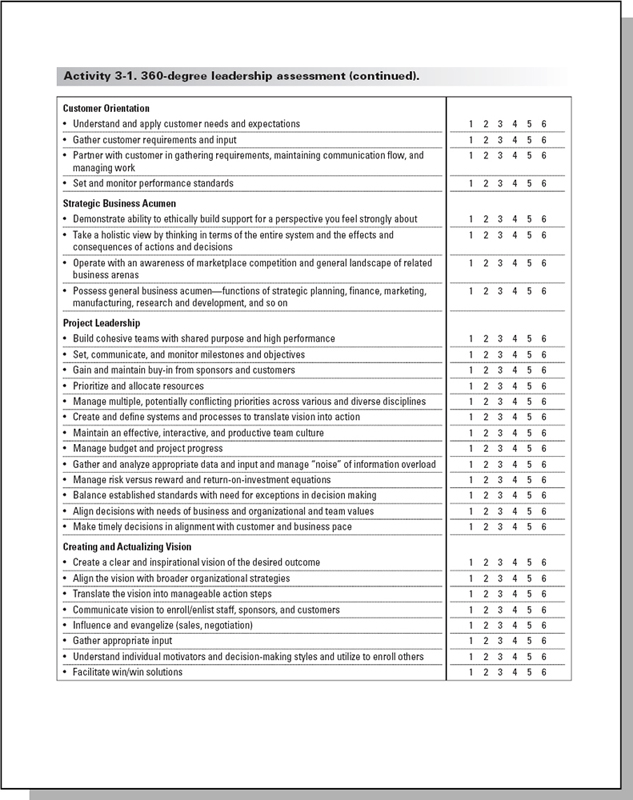
Activity 3-1, page 2
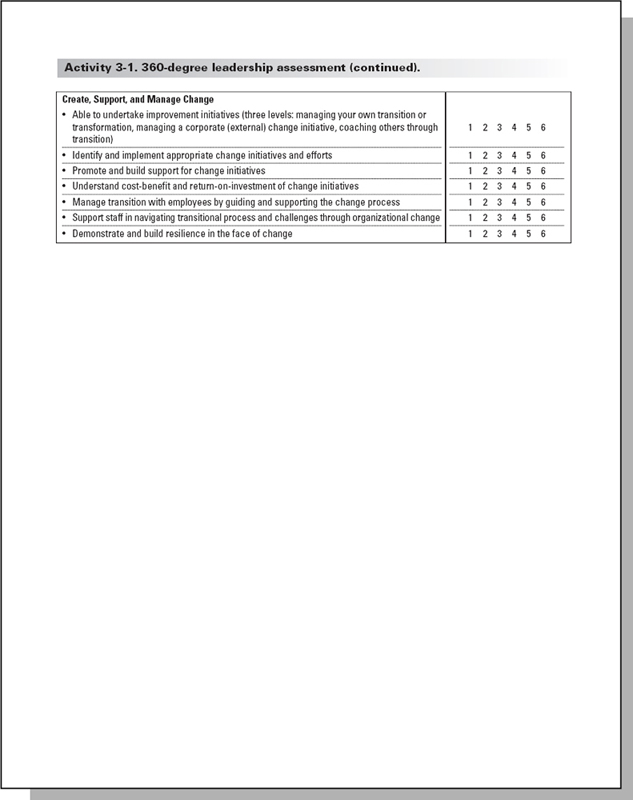
Activity 3-1, page 3

Activity 3-2

Activity 3-3

Activity 3-4
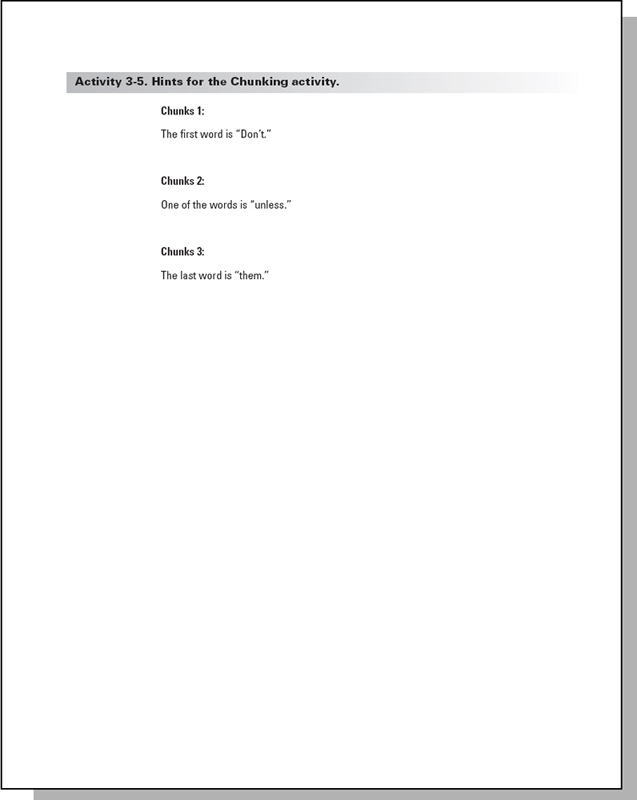
Activity 3-5
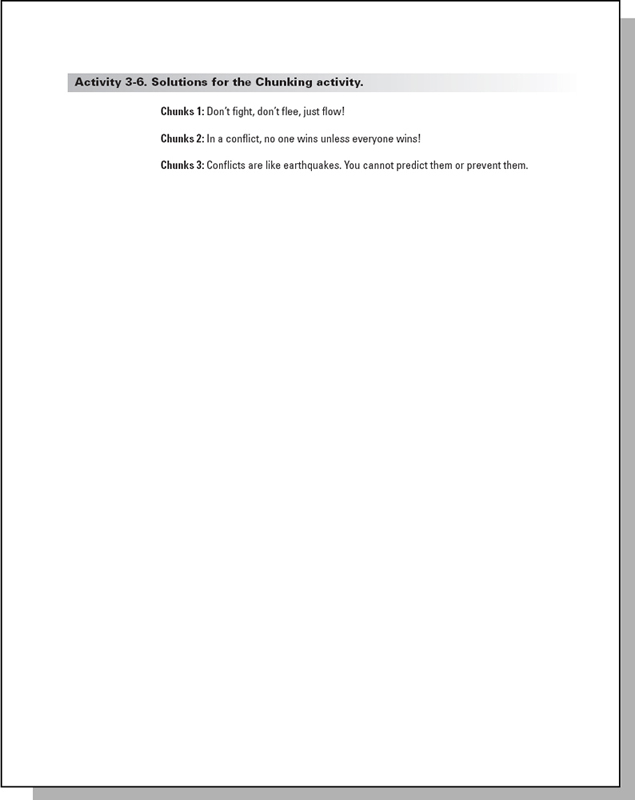
Activity 3-6

Activity 3-7
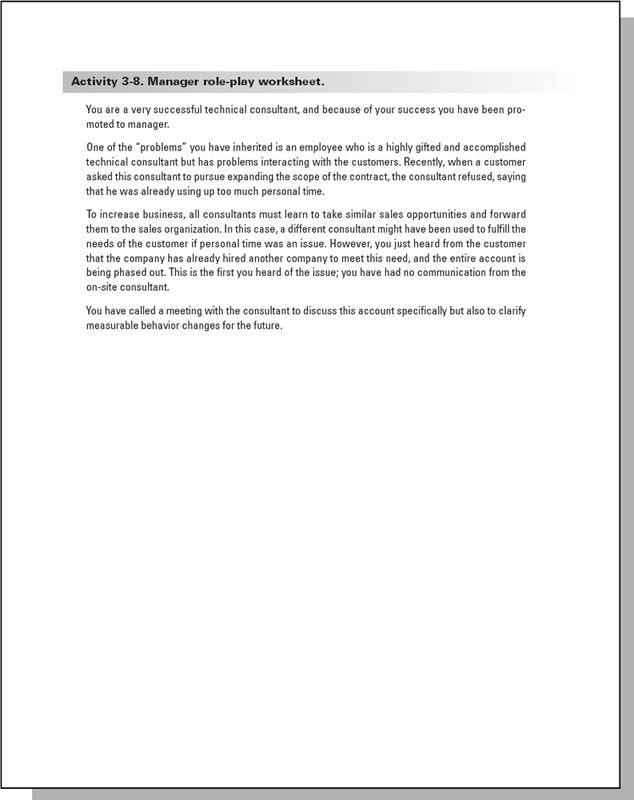
Activity 3-8
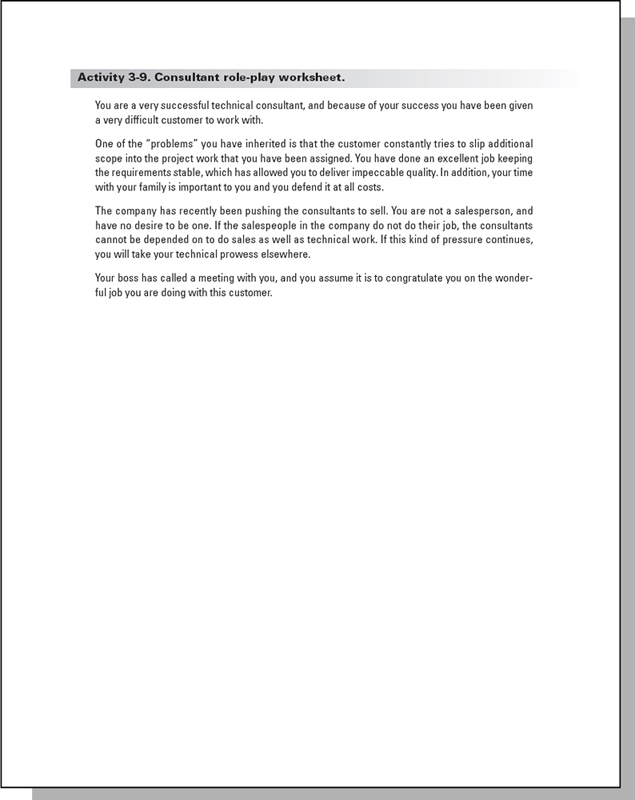
Activity 3-9
